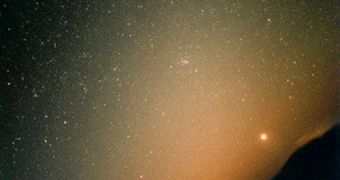NEOWISE, the extended mission of the NASA Wide-field Infrared Survey Explorer (WISE), is currently helping astronomers to keep track of near-Earth objects (NEO) that may pose a threat to the planet. Just a few days ago, it found Earth's first Trojan.
Every planet or moon out there has five special points in their orbits, called Lagrangian points. In all of them, an object remains in the same relative position in respect to the body it orbits, and the star around which it swirls.
Two of these points are located on the same orbit a body such as Earth is taking around its parent star. One of them leads the way, while the other follows. Finding them is easy – draw a line connecting Earth to the Sun, and then construct an equilateral triangle based on that line.
There are naturally two options of building the triangle, and both of them are correct. The existence of an asteroid in Earth's Lagrangian, or Trojan, points has long since been proposed, but it's only recently that the infrared (IR) instruments on the NASA telescope detected them.
WISE finished its mission quite some time ago, in October 2010. Its operations were then extended as part of the NEOWISE mission, which continued to hunt for asteroids and comets until February 2011.
In addition to objects in the Inner Asteroid Belt, between the orbits of Jupiter and Mars, the telescope also found a number of asteroids that were approaching Earth. In order for an object to be classified as a potential threat to Earth, it has to come within 5 million miles of our planet's orbit.
“WISE has already found a handful of asteroids classified as 'potentially hazardous,' including one seen in 1996 but lost until re-observed by WISE. One of our discoveries' orbit will cross Earth's orbit less than 700,000 miles away,” Ned Wright explains.
He is the principal investigator of the WISE mission, and also a professor of physics at the University of California in Los Angeles. “WISE is very good at this kind of work,” he goes on to say.
“Regional damage from a small asteroid strike can be very serious indeed. We need to keep surveying the skies to find these NEOs and precisely measure their orbits. If we can find the really dangerous asteroids early enough, we might have time to figure out how to deal with them,” Wright explains.
What WISE demonstrated yet again is that a warning network needs to be set in place, that would alert astronomers of an approaching space object. Scientists say that a 20-kilometer asteroid would be enough to eradicate all forms of complex life on Earth, Daily Galaxy reports.

 14 DAY TRIAL //
14 DAY TRIAL //